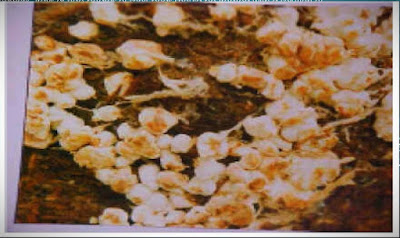Competitor Moulds of Mushroom
[Referance : NCERT BOOK]
Also Read :Fungal Diseases of mushroom
FALSE TRUFFLE :
Pathogen : Diehliomyces microspores
Common name : Truffle disease
Symptoms
Control
Compost should be prepared on a concrete floor and never on uncovered soil. Because during composting there is rise in temperature which activates the ascospores present in the soil.
Pasteurization and conditioning of the compost should be carried out carefully.
Temperature above 26-27°C during spawn run and after casing should be avoided. During cropping, temperatures should be kept below 18°C.
Woodwork, trays or side-boards of shelf-beds should be treated with a solution of sodiumpentachlorophenolate at the end of the crop which was infected with the truffle disease.
Good cooking out (compost temperature 70°C for 12h.) at the end of the crop should be carried out which will kill mycelium and spores of the pathogen in the compost.
Initial infection can be checked by treating the affected patches with formaldehyde (2%) solution.
OLIVE GREEN MOULD :
Pathogen : Chaetomium olivaceum,
C. globosum
Symptoms
The earliest signs of the fungus consist of an inconspicuous greyish-white fine mycelium in the compost or a fine aerial growth on the compost surface 10 days after spawning. By late spawn run, fruiting structures that look like gray-green cockle-burns-1/16 inch in diameter, develop on straw in isolated spots of the affected compost. The compost will have a musty odor. Compost not supporting spawn growth generally supports the growth of Chaetomium and other several moulds and hence olive green mould is not the exclusive colonizer of black compost.
Control
The fermentation period of the compost should not be too short.
Do not add nitrogen, ammonium sulphate, urea, chicken manure or similar materials just before filling.
There should be sufficient time for peak-heating and sufficient supply of fresh air during pasteurization. Higher temperatures (above 60°C) for longer time should be avoided.
Large number of fungicides including Benomyl, Thiophanate methyl, TBZ, VitalAxis, Dithane Z-78, Dithane M-45, Thiram and Captan have been found effective.
BROWN PLASTER MOULD :
Pathogen : Papulaspora byssina Hots
Symptoms
It is first noticed as whitish mycelial growth on the exposed surface of compost and casing soil in trays as well as on sides in bags due to moisture condensation.
Control
Composting should be carried out carefully, using sufficient gypsum and not too much water. Peak heating should be of sufficient duration and at proper temperatures. The compost should not be too wet before or after peak heating.
YELLOW MOULD : (Mat disease; Vert-de. gris)
Pathogen : Myceliophthora lutea, Chrysosporium luteum,
C. sulphureum
Symptoms
The yellow moulds may develop in a layer below the casing (Mat disease), form circular colonies in the compost (confetti) or they may be distributed throughout the compost (Vert-de-girs). This fungus forms a yellow brown corky mycelial layer at the interphase of compost and casing which is difficult to detect during the impregnation of casing layer by the spawn and even during the first break.
Control
Proper pasteurization of the casing mixture is very essential. Fungus does not survive the exposure for 6 hrs. at 51°C or 4 hrs. at 54°C.
Benomyl (400-500ppm) and blitox (400ppm) sprays have been found effective to control the disease and increase the yield.
SEPEDONIUM YELLOW MOULD :
Pathogen : Sepedonium spp.
Symptoms
This mould is mainly observed in the compost and is initially white in colour turning to yellow or tan at maturity. It is generally present in the lower layers of the compost or at bottom of the cropping bags. Various types of distortions in fruit bodies are commonly observed, probably due to the production of volatile substances or toxins. These toxins inhibit the spawn and ultimately mushroom mycelium disappears from the compost.
Control
Strict temperature monitoring and control during compost pasteurization and an adequate post-crop cooking out are essential to eliminate the threat of infestation. Preventing the entry of spores during spawning and spawn-running by installing high efficiency air filters are essential.
INK CAPS :
Pathogen : Coprinus spp.
Common names : Ink weed, wild mushrooms
Symptoms
Ink caps appear in the compost during spawn run or newly cased beds and outside the manure piles during fermentation. They are slender, bell-shaped mushrooms. Cream colored at first, blueish black later and are usually covered with scales. This fungus sometimes grows in clusters in beds and has a long sturdy stem which often reaches deep into the compost layer. Several days after their appearance ink caps decay and form a blackish slimy mass due to autodigestion.
Control
Use properly pasteurized compost and casing soil. Avoid excessive watering. Rogue out young fruit bodies of the weed fungus to avoid its further spread.
CINNAMON MOULD :
Pathogen : Chromelosporium fulva, C. ollare
Common name : Cinnamon brown mould, brown mould
Symptoms
The mould first appears as large circular patches of white aerial mycelium on the compost or casing. Within few days the spores are formed and the color changes from white to light yellow or to light golden brown. As the spores mature, the color changes to golden brown or cinnamon and the colony develops a granular appearance. The fungus produces numerous cup-like fleshy fruit bodies on beds.
Control
Casing soil should not be made completely sterile by steam or formaldehyde.
LIPSTICK MOULD :
Pathogen : Sporendonema purpurescens
Common name : Lipstick, Red lipstick
Symptoms
The disease first appears in spawned compost as a white crystalline-like mould, rather no discernable from spawn. As the spore of the mould mature, the colour changes from white to pink, to cherry red and then to dull orange or buff. White mycelial growth is more in loose areas of casing and can colonize well conditioned compost.
Control
Good hygiene is essential. Good pasteurization and conditioning of the compost will eliminate the pathogen.
Thank you.....

